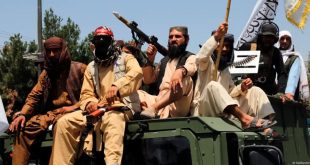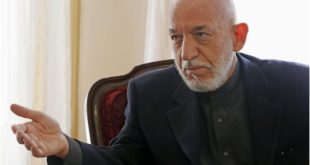By Maj Gen Ashok K Mehta (retd)-EVERY successive year, for over a decade now, New Delhi is rated in surveys as the most popular country in Afghanistan. This year, it bagged 64 per cent of the vote. Afghan Ambassador to India, Shaida Abdali, calls India a national partner. At this month’s Heart of Asia conference at Amritsar, in the presence of the Pakistan delegation led by de facto foreign minister Sartaj Aziz, President Ghani lambasted Pakistan for waging an undeclared war on Afghanistan by covertly supporting terrorist groups, including the Taliban. By suggesting that Pakistan should use the $500 m aid pledged to Afghanistan for combating terrorist networks on its soil, he struck at the heart of the problem: cross-border terrorism. The latest biannual Pentagon report states: ‘Afghanistan-oriented militant groups, including Taliban and the Haqqani network senior leadership retain freedom of action from safe havens inside Pakistan’.
President Ghani reignited the old idea of non-interference (by regional players) through an international or regional mechanism — whichever was acceptable to Pakistan — to verify terrorist intrusions and their activities inside Afghanistan. This is a total U-turn in Afghan policy towards Pakistan, a country whom Ghani would generally pay obeisance to. Now, he sounds like his predecessor, Mr Karzai, the famous Pakistan and US baiter. This reset has enhanced India-Pakistan combativeness in Pakistan.
Other strategic alignments are shaping in the region. With the US footprint likely to diminish (despite two Generals, John Mattis and Michael Flynn, being appointed Defence Secretary and National Security Adviser), regional ambitions are on the rise among Pakistan, Iran, Russia and China. A new grouping of Russia, China and Pakistan has emerged which wants to revive the peace process which died under the watch of the US-China-Afghanistan-Pakistan quadrilateral. Russia and China will not get involved proactively, except in activating the reconciliation process.
In 2013, Chinese interlocutors sounded diffident about China’s policy in Afghanistan. It was characterised by five ‘nos’: no interference in internal affairs; no criticism of US; no objection to Taliban legally entering power-sharing agreements; no use of the Northern Distribution Network; no boots on the ground. Coupled with Pakistan what has changed is Beijing’s deep involvement in Afghanistan’s political and peace process. China brings to the region elaborate connectivity programmes like the OBOR and CPEC. Last month, some 300 trucks from Chinese mainland delivered their cargo in Gwadar for onward journey to Africa. Pakistan has offered Afghanistan a connect with the CPEC through Chaman for access to Gwadar. Similarly, it has invited Russia to use the corridor.
For India, the recent Russia-Pakistan engagement is disconcerting. In September, the two countries held their first-ever military exercise in Pakistan, followed by a dialogue of officials on subjects of mutual interest, including connectivity, trade and economic cooperation. While Moscow is committed to selling four Mi-35 attack helicopters, Islamabad wants to buy Su-35 combat jets.
Russia and Iran have been talking to the Taliban for years and quietly providing material support. Russia, Iran and Pakistan are keen to alter the focus of combat in Afghanistan, from fighting the Taliban to fighting the IS, which is bound to complicate the ground situation. Russia calling the Taliban a ‘national military and political movement’ ignores the red lines imposed on the organisation by the international community. New Delhi wants the Taliban to eschew violence and follow democratic norms before it is invited to the high table. This will put two old allies, India and Russia, at odds with each other.
Little is known about the peace process other than back-channel efforts to get authentic Taliban representatives to engage in direct talks with Afghans without Pakistani presence. The Taliban has its own terms for talks with Kabul — acknowledging its political office in Doha, removal of its leaders from the sanctions list and withdrawal of foreign forces.
On the ground, there is a stalemate with the Taliban in control of one-third of the territory without any provincial or major district headquarters in its possession. According to the US commander in Afghanistan, Gen John Nicholson, who was in New Delhi last week, almost 70 per cent of the population lives under government control. A defeat of the Taliban is out of the question, as is any strategic collapse of Kabul. Afghanistan is confronted with the problem of terrorist sanctuaries in Pakistan. Only the US could have dismantled the Quetta and Peshawar Shuras but President Obama was cautious. Of the 292 drones used against terrorists, only two were used on Pakistani soil. Can Trump force Pakistan to cooperate in Pakistan? Pakistan will stick to its concept of strategic depth in Afghanistan which has been partially achieved by the Taliban controlling swathes of land contiguous with Pakistan. It also translates into a friendly government in Kabul which would allow the Taliban holding key posts in Kabul.
No dramatic change is likely. According to Afghans, the insurgents are losing 100 fighters and the government 25 soldiers a day, losses which can’t be sustained. At the last Heart of Asia conference in Islamabad, Foreign Minister Sushma Swaraj had pledged to strengthen the Afghan National Security Forces. After Pakistan let down the US and Afghanistan, the US has taken a belated hard line on Pakistan: making $400 m coalition support funds conditional on action against the Taliban and Haqqani Network, and urging India to step up military assistance to the ANSF — unthinkable two years ago.
Till recently, as the fifth largest donor — now $3 bn (the maximum India has given any country) — India used its soft power of development cooperation and capacity building. It has expanded its military training programmes for the ANSF in India. Besides non-lethal equipment, military hardware is to be provided in accordance with provisions of the 2011 strategic agreement. India should spare no effort to bolster the fighting capacity of the ANSF. It should consider doing more: deploying training teams and medical facilities in the vicinity and employing covert means to deter Pakistan’s neo-colonial concept of strategic depth. Cross-border terrorism has to be fought at source, if not in Pakistan, at least in Afghanistan which has sought our help.—(The Tribune)
The writer attended a regional conference on Afghanistan in Berlin recently
 Afghanistan Times
Afghanistan Times




